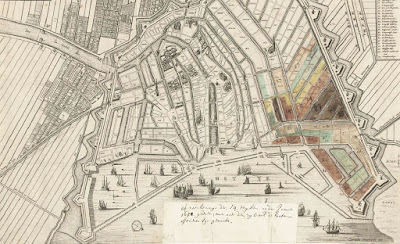[Previously discussed in May of this year.]
Joyce Lindstom in her history of the family,
VAN HOOSE VAN HOOSER VAN HUSS FAMILY IN AMERICA has identified Jan Fransse Van Husum as the first ancestor of all the Van Hoosers, Van Husses, Van Hoesens, Van Hooesrs, Hoosers in America as well as some thirty variations of the surname.
She explains that Jan was born in 1608 in the city of Husum on the Jutland Peninsula, in the Duchy of Schleswig, then part of Denmark. She goes on saying that Jan was not Dutch as most of us think. Neither was he German, for Husum and the once Duchy of Schleswig and Schleswig-Holstein now finds itself in Germany, even though not by much. He was a Schleswigan, under Danish rule.
Joyce surmises that, "He spoke low German, probably with a Frisian or Danish dialect."
We shall never rightly know if Joyce was correct. A DNA test of family members might give us some statistical evidence, but Joyce points out that living in Amsterdam, then New Holland and marriage certainly clouds the question. Then too, his wife, Volkje
Jurrianse Van Nordstrand was most likely Dutch. Her parents were farmers who settled on the island of Nordstrand. It was an island under the supervision of Dutch hydraulic engineer Jan Adriaanszoon Leeghwater.
What about Danish?
In 1252, King Abel of Denmark took an army to Husum on account of the fact that the local population refused to pay taxes and recognize Danish authority. A battle took place on the bridge at Husum (Husembro) and King Abel was killed. Old history yes, but it was a long way to Copenhagen from Husum then and now.
[There is no historically old image of King Abel's death, but we have an old sketch of
Count Willem II In Hoogwoud, Falls Through The Ice, and killed by West Frisians in
1256.
]
Who are these Frisians Joyce talks about?
The Frisians are an ancient people whose existence goes back to Roman times. They inhabited the low lands and marshes along the North Sea coast from the Sheldt River in present day Belgium, along the coast of The Netherlands, and up the western coast of the Jutland Peninsula. These ‘barbarians’ chose to live on the border between land and sea, probably as a means of protection against the Romans and other tribes. To protected themselves against floods they built hills (Dutch and Frisian,
halligen) buttressed by logs. Besides farming, they raised cattle and sheep, and no doubt engaged in trade and fishing on the sea. By the time of Caser Augustus, the Frisii seemed to have gathered around the Zuider Zee and east, just outside the reach of Roman authority which ended at the Rhine.
The Frisii reach some form of accommodations with the Romans. Don't bother us, we won't bother you. Then seeing an opportunity for plunder, Frisians joined up as legionnaires to fight in the Roman army. Traces of the Frisian legionnaires have been found at the English towns of Bicester, Burgh-by-Sands, Carrawburgh, Cirencester, Glossop, Hexham, Manchester and Papcastle.
note 1
The Roman Empire finally fell in the Fifth Century. The Frisians still lived along the coast. From the fifth century on, it seems the Frisians took part in a general
migration to Britain along with the Saxons and Angles. This fact is born
out linguistically, as English and the Frisian language are similar. By the seventh and eighth century the Kingdom of Frisia existed along the coast, succumbing for a time to Charlemagne, then battling Vikings, then regaining their independence.
Frisia would fade in time as Holland blossomed. Today the Frisian dialect is spoken in a few areas near the island of Nordstrand and that is all.
I suppose this leaves us with the adage, that history is written by the victors. Jan might have been Frisian or not. He was certainly Dutch (his descendants look Dutch, like those in this painting by Jan Van Husum's contemporary, Rembrandt), he migrated to Amsterdam after the Great Flood of 1634, married, and sailed to New Holland in 1639 where he began a new life as an American.


















